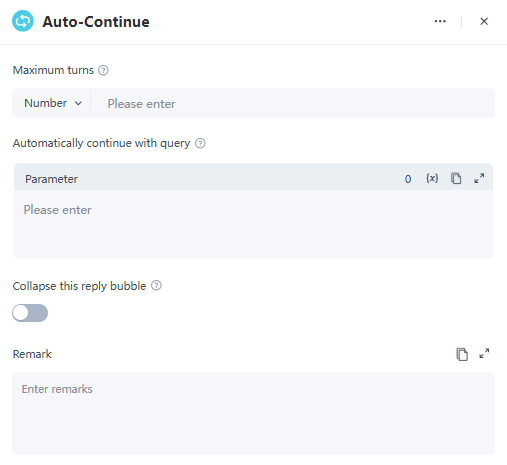Definition
The core function of the Auto-Continue node is to automatically trigger subsequent workflow nodes without human intervention once the workflow reaches this node and the auto-execution conditions are met. The node will repeatedly execute one or more subsequent steps according to predefined rules until it reaches the specified maximum number of iterations, or encounters a node that requires human input. This node is only available in conversational workflows.
How to Configure

Maximum Iterations
Number: You can specify the number of auto-continue iterations, ranging from 1 to 20, by entering the desired value in the input field.
Variable: Alternatively, you can select Variable mode from the dropdown menu and choose a variable in the input field on the right.
Query Content for Auto-Continue
Set a predefined query that will be used as the user input (Query) for each auto-continue iteration. This allows the process to proceed without manual input—ideal for scenarios that require continuous automated processing. You can quickly insert variables using the " / " key.
Collapse Reply Bubbles
If the AI’s responses during auto-continue are lengthy, enable this option to collapse the reply bubbles and enhance readability.
Advantages of the Auto-Continue Node
1. Workflow Automation
- Seamless process progression: The Auto-Continue node ensures that after one step is completed, the workflow moves to the next step automatically without manual intervention. For example, in an order processing workflow, after the order validation node checks the order details, the Auto-Continue node can advance the workflow to the payment processing step, reducing manual operations and errors.
- Enhanced efficiency: This node eliminates unnecessary waiting time. In a data processing workflow, after data cleaning is done, the Auto-Continue node immediately passes the data to the transformation step, accelerating the entire process and improving operational efficiency.
2. Simplified Operations
- Reduced manual intervention: The node minimizes the need for human monitoring and manual triggers at certain steps. For example, in automated testing workflows, after one test case runs, the Auto-Continue node moves to the next test case automatically, saving human effort.
- Simplified workflow design: The node helps create cleaner and more intuitive workflows. In a business process with multiple approval steps, Auto-Continue nodes can link approvals together, making the workflow clearer and easier to maintain.
3. Ensured Workflow Continuity
- Prevent process interruptions: Auto-Continue nodes maintain workflow continuity and prevent disruptions due to human error or oversight. For instance, in a production line material handling process, after a material handling step is completed, the Auto-Continue node ensures the material proceeds to the next stage without delay.
- Stable execution: The node supports stable, orderly execution of workflows. In a software deployment pipeline, it helps maintain the correct sequence from code compilation to testing to production deployment, reducing risks caused by human error.
Common usage scenarios
Multi-agent collaboration:
When multiple agents repeatedly query enterprise knowledge bases or external APIs to obtain satisfactory answers, Auto-Continue nodes can handle several iterations automatically without requiring the user to confirm each step.
Example: In an intelligent legal consulting system, different agents handle different areas of law. When a user submits a complex legal query, the system uses Auto-Continue nodes to repeatedly query knowledge bases and APIs, trying different strategies until it provides comprehensive legal advice—all without requiring the user’s confirmation at each step.
Human-in-the-loop:
Auto-Continue nodes drive automatic iterations first, and only transfer control to humans when automation can no longer resolve the decision, balancing efficiency and safety.
Example: In a financial risk assessment workflow, Auto-Continue nodes repeatedly invoke risk models and external data sources. If uncertainty remains or exceptional cases arise (e.g., unusual market fluctuations), the process pauses for a financial analyst to review.
FAQs
Loop nodes repeatedly execute the same business logic (e.g., fixed iterations or collection traversal), typically used for batch data processing. Auto Continue nodes focus on flexible iterations in conversational workflows based on human intervention needs and preset limits.
In complex scenarios, both may be used—for example, first using a Loop node for initial analysis of user feedback, then an Auto Continue node for interactive refinement based on user responses.
Unlike traditional bots that end the flow after a single Q&A, conversational workflows with Auto Continue nodes flexibly advance the process through multiple turns as needed.
Whether to continue depends on business logic—for example, continuing until complete, accurate information is obtained—rather than ending after one interaction.
Yes. Branch nodes direct workflows along different paths based on conditions, and Auto Continue nodes can work within these branches to handle automatic loops.
Example: In a customer service workflow, a Branch node directs the issue to the right team, while an Auto Continue node can repeatedly query knowledge bases or try solutions within that branch until the issue is resolved.
Leave a Reply.